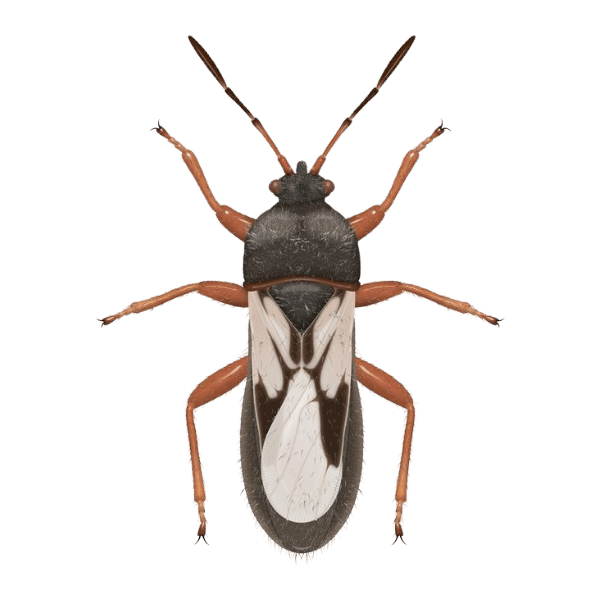Intro to the Insect:
Chinch bugs are small but highly destructive pests that thrive in the hot, dry conditions of North Alabama. These insects primarily feed on turfgrass, sucking sap from the blades and injecting a toxin that causes grass to wither and die. St. Augustine grass is their preferred host, but they can also infest Bermuda and zoysia grass. Chinch bugs are most active during summer, when their populations peak, making them a major concern for homeowners looking to maintain a healthy lawn.
Which Ones Are Common in My Area and How Can I Identify Them?
The southern chinch bug (Blissus insularis) is the most common species in North Alabama. Identifying characteristics include:
- Size: Adults are about 1/6 inch long.
- Color: Black bodies with white wings and a distinct black triangle on the back.
- Behavior: They cluster at the base of grass stems, often in sunny, dry areas of the lawn.
Signs of an infestation include yellowing grass that quickly turns brown and spreads in irregular patterns.
How Did I Get the Insect?
Chinch bugs are often introduced to lawns under specific conditions, such as:
- Excessive thatch buildup, which provides shelter and breeding grounds.
- Hot, dry weather, which creates ideal conditions for their reproduction.
- Proximity to untreated areas where they migrate into residential lawns.
Understanding their preferences helps mitigate their spread and reduce damage.
What Effects Does This Have on My Lawn or Outdoor Space?
Chinch bugs cause damage by feeding on grass and injecting a toxin, leading to:
- Yellow Patches: Grass first appears water-stressed before turning yellow and brown.
- Grass Death: Severe infestations can kill large sections of turf.
- Uneven Lawn: Damaged areas create an unsightly, patchy appearance.
Without treatment, chinch bug activity can spread quickly, requiring significant lawn repairs.
How Long Do They Live?
Chinch bugs have multiple generations per year, particularly during North Alabama’s long, warm summers:
- Eggs hatch in 1–2 weeks.
- Nymphs mature into adults in 4–6 weeks.
- Adults can live for several weeks, reproducing rapidly during their lifespan.
Their lifecycle allows populations to grow quickly, especially in untreated areas.
How Do I Prevent Them?
Preventing chinch bugs involves proper lawn care and regular monitoring. Steps include:
- Thatch Control: Remove excessive thatch buildup to eliminate hiding places.
- Proper Irrigation: Maintain consistent watering to avoid drought stress on the lawn.
- Early Detection: Inspect sunny areas of the lawn for signs of clustering bugs or damage.
These practices help maintain a healthy lawn that is less susceptible to chinch bugs.
How Guardian South Helps:
Our experts provide targeted insecticides to eliminate chinch bugs and prevent future infestations. We also offer lawn restoration services to repair damage and keep your lawn healthy throughout the year.

